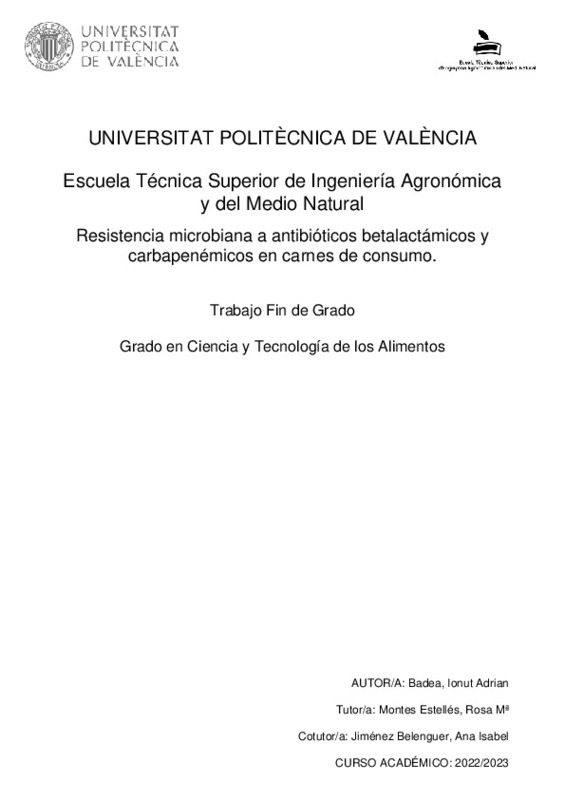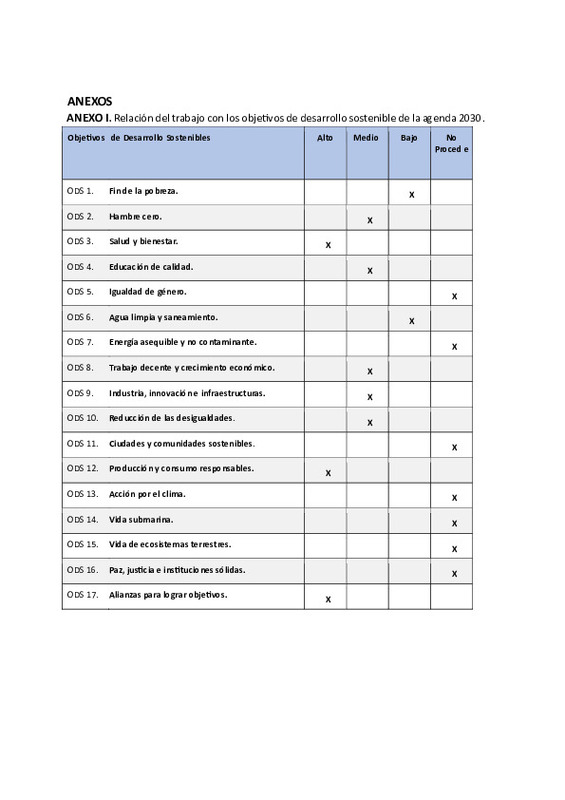JavaScript is disabled for your browser. Some features of this site may not work without it.
Buscar en RiuNet
Listar
Mi cuenta
Estadísticas
Ayuda RiuNet
Admin. UPV
Resistencia microbiana a antibióticos betalactámicos y carbapenémicos en carnes de consumo
Mostrar el registro sencillo del ítem
Ficheros en el ítem
| dc.contributor.advisor | Montes Estellés, Rosa Mª
|
es_ES |
| dc.contributor.advisor | Jiménez Belenguer, Ana Isabel
|
es_ES |
| dc.contributor.author | Badea, Ionut Adrian
|
es_ES |
| dc.date.accessioned | 2023-09-14T14:55:21Z | |
| dc.date.available | 2023-09-14T14:55:21Z | |
| dc.date.created | 2023-07-27 | |
| dc.date.issued | 2023-09-14 | es_ES |
| dc.identifier.uri | http://hdl.handle.net/10251/196492 | |
| dc.description.abstract | [ES] En los últimos años la resistencia de las bacterias a los antibióticos se ha posicionado como un gran problema de salud pública, suponiendo cada año más de 2,8 millones de infecciones resistentes a los antimicrobianos. En Europa 33000 personas fallecen anualmente como consecuencia de infecciones hospitalarias causadas por bacterias resistentes a los antibióticos. Recientes estudios han observado que la resistencia antibiótica no solo se da en el ámbito humano debido al uso indebido de antibióticos en clínica, sino que el uso en todos los ámbitos, incluyendo la producción primaria de alimentos: ganadería, agricultura, y uso veterinario de los mismos, puede suponer una vía de entrada de estas bacterias portadoras de genes de resistencia antibiótica en la cadena alimentaria y suponer un riesgo para el consumidor. En el presente trabajo se estudia la calidad microbiológica de distintos cortes de carnes destinadas al consumo humano y la presencia de patógenos como Listeria monocytogenes mediante la ISO 11290:2017, siendo que el 23,33% de las muestras contenían alguna cepa de Listeria. Se aislaron 11 bacterias de medios suplementados con cefalosporinas de 3º generación y antibióticos carbapenémicos a los que una vez identificados se procedió al estudio de sus perfiles de resistencia mediante antibiograma. Se detectaron 8 cepas de bacterias diferentes, siendo la mayoría de ellos resistentes a Ampicilina y Amoxicilina. Una de estas bacterias, Rauoutella ornithinolytica, fue resistente a 3 grupos de antibióticos diferentes, clasificándose así como mutirresistente. Este estudio se le realizó también a las 29 cepas de E. coli para identificar su resistencia fenotípica a los 12 antibióticos de interés clínico. La mayor resistencia presentada por estas bacterias fue a la Amoxicilina (68,97%) seguida por el Ácido Nalidíxico (55,17%). Una de estas cepas presentó resistencia a 4 antibióticos, siendo 3 de ellos de diferente grupo antibacteriano, por lo que se clasificó como multirresistente. Un brote provocado por algunas de estas bacterias resistentes a antibióticos, especialmente por las multirresistentes, ya que no se han empleado buenas practicas en la preparación, puede suponer un gran problema por la dificultad de su tratamiento. Para que este problema no se agrave se deben promover prácticas de desarrollo sostenibles en todo el mundo. Esto se puede conseguir siguiendo algunos de los Objetivos de Desarrollo Sostenibles (ODS) propuestos por las Naciones Unidas como son el ODS 4: Educación de calidad ODS; el 9: Industria, innovación e infraestructura; el ODS 12: Producción y consumo responsables; ODS 17: Alianzas para lograr los objetivos. Si se consiguen promover estos y hacer que se reduzca el problema esto afectará a otros ODS a cumplirse y a no agravarse como los son el ODS 1: Fin de la pobreza; ODS 2: Hambre cero; ODS 3: Salud y bienestar; ODS 6: Agua limpia y saneamiento; ODS 8: Trabajo decente y crecimiento económico; ODS 10: Reducción de las desigualdades. | es_ES |
| dc.description.abstract | [EN] In recent years, bacterial resistance to antibiotics has become a major public health problem, with more than 2.8 million antimicrobial-resistant infections occurring each year. In Europe 33,000 people die annually as a result of hospital infections caused by antibiotic-resistant bacteria. Recent studies have observed that antibiotic resistance not only occurs in the human field due to the misuse of antibiotics in the clinic, but also the use in all areas, including primary food production: livestock, agriculture, and veterinary use of antibiotics, may represent a route of entry for these bacteria carrying antibiotic resistance genes into the food chain and pose a risk to the consumer. In the present study, the microbiological quality of different cuts of meat intended for human consumption and the presence of pathogens such as Listeria monocytogenes are studied using ISO 11290:2017, with 23.33% of the samples containing some strain of Listeria. Eleven bacteria were isolated from media supplemented with 3rd generation cephalosporins and carbapenem antibiotics. Once identified, their resistance profiles were studied using an antibiogram. 8 different strains of bacteria are detected, most of them resistant to Ampicillin and Amoxicillin. One of these bacteria, Rauoutella ornithinolytica, was resistant to 3 different groups of antibiotics, thus being classified as multi-resistant. This study was also carried out on the 29 E. coli strains to identify their phenotypic resistance to the 12 antibiotics of clinical interest. The greatest resistance presented by these bacteria was to Amoxicillin (68.97%) followed by Nalidixic Acid (55.17%). One of these strains presented resistance to 4 antibiotics, 3 of them from a different antibacterial group, which is why it was classified as multiresistant. An outbreak caused by some of these antibiotic-resistant bacteria, especially the multi-resistant ones, since good preparation practices have not been used, can be a big problem due to the difficulty of treating it. So that this problem does not worsen, sustainable development practices must be promoted throughout the world. This can be achieved by following some of the Sustainable Development Goals (SDG) proposed by the United Nations, such as SDG 4: Quality education SDG; 9: Industry, innovation and infrastructure; SDG 12: Responsible consumption and production; SDG 17: Partnerships to achieve the goals. If these are promoted and the problem is reduced, this will affect other SDGs to be met and not worsen, such as SDG 1: End of poverty; SDG 2: Zero hunger; SDG 3: Health and well-being; SDG 6: Clean water and sanitation; SDG 8: Decent work and economic growth; SDG 10: Reduction of inequalities. | es_ES |
| dc.format.extent | 38 | es_ES |
| dc.language | Español | es_ES |
| dc.publisher | Universitat Politècnica de València | es_ES |
| dc.rights | Reserva de todos los derechos | es_ES |
| dc.subject | Listeria | es_ES |
| dc.subject | Resistencia antibióticos | es_ES |
| dc.subject | Bacterias | es_ES |
| dc.subject | Betalactámicos | es_ES |
| dc.subject | Carbapenenos | es_ES |
| dc.subject | Antibiotic resistance | es_ES |
| dc.subject | Bacteria | es_ES |
| dc.subject | Beta-lactams | es_ES |
| dc.subject | Carbapenens | es_ES |
| dc.subject.classification | MICROBIOLOGIA | es_ES |
| dc.subject.other | Grado en Ciencia y Tecnología de los Alimentos-Grau en Ciència i Tecnologia dels Aliments | es_ES |
| dc.title | Resistencia microbiana a antibióticos betalactámicos y carbapenémicos en carnes de consumo | es_ES |
| dc.title.alternative | Microbial resistance to beta-lactam and carbapenem antibiotics in consumer meats. | es_ES |
| dc.title.alternative | Resistència microbiana a antibiòtics betalactàmics i carbapenèmics en carns de consum. | es_ES |
| dc.type | Proyecto/Trabajo fin de carrera/grado | es_ES |
| dc.rights.accessRights | Abierto | es_ES |
| dc.contributor.affiliation | Universitat Politècnica de València. Departamento de Biotecnología - Departament de Biotecnologia | es_ES |
| dc.contributor.affiliation | Universitat Politècnica de València. Escuela Técnica Superior de Ingeniería Agronómica y del Medio Natural - Escola Tècnica Superior d'Enginyeria Agronòmica i del Medi Natural | es_ES |
| dc.description.bibliographicCitation | Badea, IA. (2023). Resistencia microbiana a antibióticos betalactámicos y carbapenémicos en carnes de consumo. Universitat Politècnica de València. http://hdl.handle.net/10251/196492 | es_ES |
| dc.description.accrualMethod | TFGM | es_ES |
| dc.relation.pasarela | TFGM\157010 | es_ES |
Este ítem aparece en la(s) siguiente(s) colección(ones)
-
ETSIAMN - Trabajos académicos [3278]
Escuela Técnica Superior de Ingeniería Agronómica y del Medio Natural







